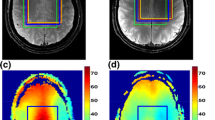Abstract
Significant 31P NMR signal enhancement through heteronuclear polarisation transfer was obtained in model solutions and in vivo on a 1.5-T whole-body MR scanner equipped with two RF channels. The much higher population differences involved in proton Zeeman energy levels can be transferred to the 31P levels with the refocused INEPT (insensitive nucleus enhancement by polarisation transfer) double-resonance experiment by means of a series of simultaneously applied broadband RF pulses. INEPT achieves a polarisation transfer from 1H to 31P spin states by directly reordering the populations in spin systems with heteronuclear scalar coupling. Thus, only the 31P NMR signal of metabolites with scalar 1H–31P coupling is amplified, while the other metabolite signals in the spectra are suppressed. Compared to Ernst-angle excitation, a repetition-time-dependent signal enhancement of η=(29±3)% for methylene diphosphonic acid (MDPA) and η=(56±1)% for phosphorylethanolamine (PE) was obtained on model solutions through optimisation of the temporal parameters of the pulse experiment. The results are in good agreement with numerical calculations of the theoretical model for the studied spin systems. With optimised echo times, in-vivo 31P signal enhancement of the same order was obtained in studies of the human brain.









Similar content being viewed by others
References
Gonen O, Mohebbi A, Stoyanova R, Brown TR (1997) In vivo phosphorus polarization transfer and decoupling from protons in three-dimensional localized nuclear magnetic resonance spectroscopy of human brain. Magn Reson Med 37:301–6
Payne GS, Leach MO (2000) Surface-coil polarization transfer for monitoring tissue metabolism in vivo. Magn Reson Med 43:510–6
Lara RS, Matson GB, Hugg JW, Maudsley AA, Weiner MW (1998) Quantitation of in vivo phosphorus metabolites in human brain with magnetic resonance spectroscopic imaging (MRSI). Magn Reson Imaging 1993;11:273–8
de Graaf RA (1998) In vivo NMR spectroscopy. Wiley, West Sussex
Richardson AJ, Allen SJ, Hajnal JV, Cox IJ, Easton T, Puri BK (2001) Associations between central and peripheral measures of phospholipid breakdown revealed by cerebral 31-phosphorus magnetic resonance spectroscopy and fatty acid composition of erythrocyte membranes. Prog Neuropsychopharmacol Biol Psychiatry 25:1513–21
Burum DP, Ernst RR (1980) Net polarization transfer via a J-ordered state for signal enhancement of low-sensitivity nuclei. J Magn Reson 39:163–168
Morris GA, Freeman R (1979) Enhancement of nuclear magnetic resonance signals by polarization transfer. J Am Chem Soc 101:760–762
Matson GB, Vermathen P, Hill TC (1999) A practical double-tuned 1H/31P quadrature birdcage headcoil optimized for 31P operation. Magn Reson Med 42:173–82
Luyten PR, Bruntink G, Sloff FM, Vermeulen JW, van der Heijden JI, den Hollander JA, Heerschap A (1989) Broadband proton decoupling in human 31P NMR spectroscopy. NMR Biomed 1:177–83
Smith SA (1999) GAMMA users manual. http://gamma.magnet.fsu.edu
Vanhamme L, van den Boogaart A, Van Huffel S (1997) Improved method for accurate and efficient quantification of MRS data with use of prior knowledge. J Magn Reson 129:35–43
Kilby PM, Allis JL, Radda GK (1990) Spin-spin relaxation of the phosphodiester resonance in the 31P NMR spectrum of human brain. The determination of the concentrations of phosphodiester components. FEBS Lett 272:163–5
Deicken RF, Calabrese G, Merrin EL, Meyerhoff DJ, Dillon WP, Weiner MW, Fein G (1994) 31Phosphorus magnetic resonance spectroscopy of the frontal and parietal lobes in chronic schizophrenia. Biol Psychiatry 36:503–510
Shioiri T, Kato T, Inubushi T, Murashita J, Takahashi S (1994) Correlations of phosphomonoesters measured by phosphorus-31 magnetic resonance spectroscopy in the frontal lobes and negative symptoms in schizophrenia. Psychiatry Res 55:223–35
Volz HP, Rzanny R, Rossger G, Hubner G, Kreitschmann-Andermahr I, Kaiser WA, Sauer H (1998) 31Phosphorus magnetic resonance spectroscopy of the dorsolateral prefrontal region in schizophrenics - a study including 50 patients and 36 controls. Biol Psychiatry 44:399–404.
Bluml S, Tan J, Harris K, Adatia N, Karme A, Sproull T, Ross B (1999) Quantitative proton-decoupled31P MRS of the schizophrenic brain in vivo. J Comput Assist Tomogr 23:272–5
Potwarka JJ, Drost DJ, Williamson PC, Carr T, Canaran G, Rylett WJ, Neufeld RW (1999) A1 H-decoupled 31P chemical shift imaging study of medicated schizophrenic patients and healthy controls. Biol Psychiatry 45:687–93
Volz HP, Rzanny R, Riehemann S, May S, Hegewald H, Preussler B, Hubner G, Kaiser WA, Sauer H (1998) 31P magnetic resonance spectroscopy in the frontal lobe of major depressed patients. Eur Arch Psychiatry Clin Neurosci 248:289–95
Yildiz A, Sachs GS, Dorer DJ, Renshaw PF (2001) 31P nuclear magnetic resonance spectroscopy findings in bipolar illness: a meta-analysis. Psychiatry Res 106:181–91
Gonzalez RG, Guimaraes AR, Moore GJ, Crawley A, Cupples LA, Growdon JH (1996) Quantitative in vivo 31P magnetic resonance spectroscopy of Alzheimer disease. Alzheimer Dis Assoc Disord 10:46–52
Smith CD, Pettigrew LC, Avison MJ, Kirsch JE, Tinkhtman AJ, Schmitt FA, Wermeling DP, Wekstein DR, Markesberry WR (1995) Frontal lobe phosphorus metabolism and neuropsychological function in aging and in Alzheimer's disease. Ann Neurol 38:194–201
Podo F (1999) Tumour phospholipid metabolism. NMR Biomed 12:413–39
Maintz D, Heindel W, Kugel H, Jaeger R, Lackner KJ (2002) Phosphorus-31 MR spectroscopy of normal adult human brain and brain tumours. NMR Biomed 15:18–27
Acknowledgements
The authors thank Gerald Matson (UCSF, San Francisco) for building the double-tuned head coil and William E. Hull (DKFZ, Department: Central Spectroscopy) for the acquisition and interpretation of high-resolution MR spectra from MDPA and PE.
Author information
Authors and Affiliations
Corresponding author
Rights and permissions
About this article
Cite this article
Weber-Fahr, W., Bachert, P., Henn, F.A. et al. Signal enhancement through heteronuclear polarisation transfer in in-vivo 31P MR spectroscopy of the human brain. Magn Reson Mater Phy 16, 68–76 (2003). https://doi.org/10.1007/s10334-003-0008-6
Received:
Accepted:
Published:
Issue Date:
DOI: https://doi.org/10.1007/s10334-003-0008-6




